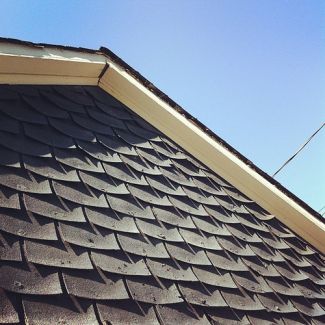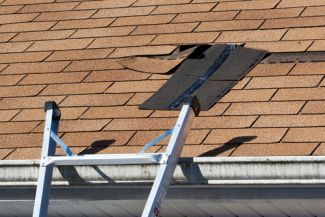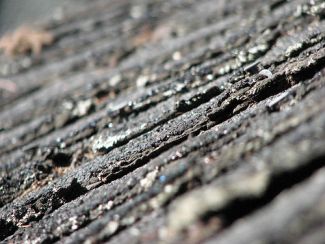How to Tell if You Need a New Roof

Your home's roof protects you, your family, and your entire house from nature's elements. Like anything else, a roof requires regular care and maintenance in order to function properly and last as long as possible. Of course, wear and tear is inevitable. Even the best constructed roof will wear out eventually.
Some signs that you need to replace your roof are obvious, like water leaking through multiple places in your ceiling! Other signs are not as apparent and require a more thorough inspection to diagnose. Here are some telltale warning signs that you may need a new roof.
Curling or Cupping Shingles
 Curling is a common problem on roof shingles and typical causes include: improper shingle storage prior to installation, incorrect installation, excessively dry asphalt shingle bases, poor quality materials, or just natural wear. When shingles curl, they are no longer able to keep water from seeping through your roof, which could potentially cause serious structural damage.
Curling is a common problem on roof shingles and typical causes include: improper shingle storage prior to installation, incorrect installation, excessively dry asphalt shingle bases, poor quality materials, or just natural wear. When shingles curl, they are no longer able to keep water from seeping through your roof, which could potentially cause serious structural damage.
If your roof's shingles are curled, do not attempt to walk on them, as this will only cause them to break off. Once shingles have gotten to this point, there is no way to halt or reverse the process, unfortunately. It is best to just replace them all. After you install new shingles on your roof, diligent care will help them last. Make sure you inspect them at least once per year for signs of damage or wear and replace them as necessary. It is also a good idea to check shingles for damage after strong wind storms or extreme temperature shifts.
Shoddy Workmanship
Unfortunately, some roof problems simply result from poor craftsmanship. If the roof was installed by an unscrupulous contractor or an inexperienced homeowner, it will often show. Ultimately, an incorrectly installed roof will dramatically shorten its useful life and could even invite serious water damage to your home.
Telltale signs of poor-quality workmanship include obvious and excessive patching on the roof or shingles that fit together awkwardly. Multiple layers of shingles also signal that corners were cut in a previous roof job. Years ago, it was common practice to install new shingles directly on top of the old ones to save money and time. However, this actually damages the top layer of new shingles, which essentially end up getting baked by heat from the layer(s) below. This practice is no longer considered acceptable and will probably void the warranty on your new shingles.
Missing Shingles
 Shingles only protect your roof if they are all intact. Missing shingles create convenient openings, through which water can enter your home. Shingles can be pulled off your roof by strong winds or falling tree branches and can also be broken by repeated freezing and thawing. However, take special note if your shingles come off without any real provocation – if this happens they are definitely worn out.
Shingles only protect your roof if they are all intact. Missing shingles create convenient openings, through which water can enter your home. Shingles can be pulled off your roof by strong winds or falling tree branches and can also be broken by repeated freezing and thawing. However, take special note if your shingles come off without any real provocation – if this happens they are definitely worn out.
Missing shingles must be replaced as soon as possible, whereas loose shingles should be sealed with flashing cement. Make sure this cement conforms to the ASTM D4586 asbestos-free standards. If you plan to handle this cement yourself, you should know that some types still contain hazardous substances. Make sure that you thoroughly read and understand the manufacturer's instructions and wear the appropriate safety gear before using flashing cement on your roof.
Decaying Shingles
 All roofing materials will eventually deteriorate. Often, shingles on a roof will not all go bad at once. Deteriorating shingles are actually fairly easy to notice. Look for any splitting, cracking, chipping, peeling, curling, or blistering and replace the affected shingles as necessary.
All roofing materials will eventually deteriorate. Often, shingles on a roof will not all go bad at once. Deteriorating shingles are actually fairly easy to notice. Look for any splitting, cracking, chipping, peeling, curling, or blistering and replace the affected shingles as necessary.
Blistering When moisture or gas builds up inside of a shingle, it can cause the surface to bubble outward in places. This is known as blistering. Conditions that cause blistering can include a poorly ventilated attic, leaf or debris buildup, or just natural roof aging. Additionally, intense sunlight exposure can cause or exacerbate a blistering problem.
Blistered shingles are not necessarily a death sentence for your roof. As long as the blisters stay smaller than one-quarter of an inch and do not break open, they should not affect the useful lifespan of your roof. It is a good idea to check your roof regularly for signs of blistering and to make sure that any existing blisters have remained closed.
Damaged Flashing
 Flashing is a layer of metal sheeting, usually made from copper, tin, or aluminum, installed at an angle or joint in your roof, which prevents water from breaching the roof. The most common place to find flashing is around your chimney or sewer vent pipe.
Flashing is a layer of metal sheeting, usually made from copper, tin, or aluminum, installed at an angle or joint in your roof, which prevents water from breaching the roof. The most common place to find flashing is around your chimney or sewer vent pipe.
Asphalt roof shingles require “step flashing,” which are individual pieces of flashing covering each shingle and overlapping onto the shingle down slope. This application is usually needed where a sloping roof passes a vertical surface like a chimney. By using an individual piece of flashing for each shingle or row of shingles, a water tight seal can be maintained over time, despite daily shingle expansion and contraction from temperature swings. A larger, single piece of metal would crack apart from this expansion and contraction, letting water into the structure.
Flashing can also be damaged by forces like wind, snow, ice, hail, or falling tree branches. Of course, improper installation is also a common culprit. Many people prefer to caulk their flashing back into place to make it look better, but this is not always a reliable repair method. To ensure optimal protection for your roof, it is important to properly repair any damaged flashing. If you are unsure whether your flashing is in proper condition, consult a roofing expert to make sure it is not a weak point on your roof.
Rotting
 If your roof is rotting, the problem should be fairly obvious and must be remedied immediately. Rot is most common in wooden shingles, but can also occur in the asphalt variety. If the shingle absorbs excessive moisture over time, rot can result. Of course, rotten shingles tend to occur most often in geographic areas with significant humidity or rainfall.
If your roof is rotting, the problem should be fairly obvious and must be remedied immediately. Rot is most common in wooden shingles, but can also occur in the asphalt variety. If the shingle absorbs excessive moisture over time, rot can result. Of course, rotten shingles tend to occur most often in geographic areas with significant humidity or rainfall.
If some shingles are rotting, the rest could follow soon. Rather than wasting time and energy replacing many individual shingles and prolonging the inevitable, you should bite the bullet and replace them all.
Algae Buildup
Algae growth is worth mentioning here as well. Fortunately, however, it is NOT a sign that something is wrong with your roof or that you need to replace shingles. Although algae does discolor shingles, causing an eyesore, the algae buildup itself is not harmful to your roof. This problem is typical in humid geographic regions, especially for homeowners with shake roofs.
Algae is fairly simple to control. If you spray it forcefully with a garden hose, you should be able to remove a good amount of it. If the buildup is extremely thick, you may want to consider replacing your existing shingles with algae-resistant ones. You can also use a weak solution of hydrogen peroxide, mixed with water to deal with persistent algae.
A healthy roof on your home is important. It keeps you and the structure safe. Stay vigilant and monitor your roof for signs of wear or damage, and take early action to correct problems before they get worse. Finally, it is always a good idea to consult a roof expert before embarking on a maintenance project, or if you are unsure of your roof’s condition. To help your roof last a long time, see our article on avoiding roof problems. Or if it's time to replace, here is our article on how much a new roof costs.
Image sources: architecturegeek, daleus, dolfindans, and dbjorn
 The How to Tell if You Need a New Roof by Water Damage Defense, is licensed under a Creative Commons Attribution-ShareAlike 3.0 Unported License.
The How to Tell if You Need a New Roof by Water Damage Defense, is licensed under a Creative Commons Attribution-ShareAlike 3.0 Unported License.
